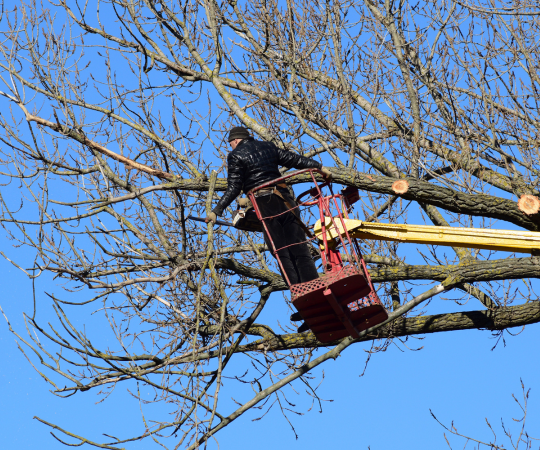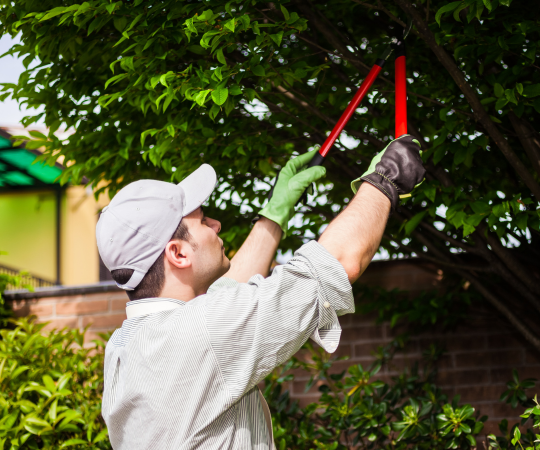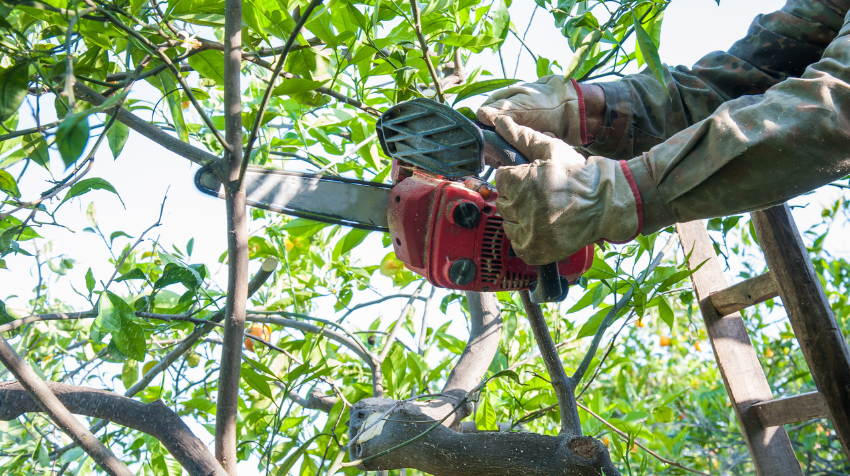Mastering the Art of Pruning: A Definitive Guide to Safely and Effectively Prune Large Trees
Are you looking to tame the giants in your yard? Pruning large trees can be a daunting task, but with the right tools and strategy, it can be done safely and effectively.
In this step-by-step guide, we will walk you through the process of assessing your tree’s health and pruning needs, gathering necessary tools and equipment, planning your pruning strategy, beginning the pruning process, cleaning up and disposing of branches, and maintaining your tree’s health.
Whether you’re a seasoned gardener or a homeowner with little experience in tree care, tackling a large tree can seem overwhelming. But don’t worry – by following these steps and taking the time to properly prepare for pruning day, you can ensure that your tree stays healthy and looks beautiful for years to come.
So grab your safety gear and let’s get started on taming those giants!
Assess Your Tree’s Health and Pruning Needs
Before you start cutting, take a moment to evaluate your tree’s health and determine its specific pruning needs. A healthy tree is crucial for a successful pruning process. Check the tree for any signs of disease or damage, such as dead or broken branches, discolored leaves, and cracks in the trunk. These are indications that your tree may require special attention.
Once you have assessed your tree’s health, determine its specific pruning needs. Identify which branches need to be removed or cut back based on their location and size. Focus on eliminating any crossing limbs or those growing towards the center of the tree as they can cause damage to other branches or obstruct sunlight from reaching lower parts of the tree.
Once you have determined what needs to be pruned, it’s time to gather the necessary tools and equipment.
Gather the Necessary Tools and Equipment
Get your hands on the right tools and equipment to make sure you can safely and easily trim your trees. For small trees, you may only need a pair of pruning shears or loppers. However, for larger trees that require more extensive work, you’ll need heavier-duty equipment such as chainsaws, pole saws, and hand saws.
When selecting tools, make sure they’re designed for tree care and are in good working order. Inspect blades for sharpness and ensure that chainsaws have proper tensioning before starting work. Safety gear is also crucial – wear gloves to protect your hands from blisters and cuts, safety glasses to shield your eyes from flying debris, sturdy shoes with slip-resistant soles to prevent falls, and a hard hat to protect your head from falling branches.
Once you have all the necessary equipment in place, it’s time to plan your pruning strategy.

Plan Your Pruning Strategy
To effectively trim your trees, it’s important to develop a pruning strategy that takes into account the size and shape of the tree, as well as its overall health and growth patterns.
Start by identifying any dead or diseased branches that need to be removed first. Then, consider the natural shape of the tree and aim to maintain this while removing any branches that are growing too close together or crossing over each other.
Next, decide on the height you want your tree to be and plan your cuts accordingly. If you’re unsure about where to start with pruning, consult an arborist for advice.
Remember that pruning is a delicate process and should never be rushed. Take your time to carefully plan out your cuts so that you end up with a healthy, beautiful tree.
Now that you have a solid strategy in place, it’s time to begin pruning!
Begin Pruning
Now it’s time to roll up your sleeves and start trimming those trees like a seasoned pro. Before you begin, make sure you have all the necessary tools, including pruning shears, loppers, hand saws, and pole pruners. You should also wear protective clothing such as gloves and safety glasses to prevent injuries from falling branches or flying debris.
When starting the pruning process, always cut back to a lateral branch or bud that is at least one-third the diameter of the branch being removed. This will help ensure that the tree can properly heal itself without causing damage or disease. Work your way up from smaller branches to larger ones, taking care not to over prune any one area. Remember to step back frequently and assess your progress as you go along.
With patience and attention to detail, you’ll be able to transform even the most unruly trees into well-managed works of art in no time.
As you finish up with each branch, make sure to clean up any debris on the ground below before moving on.
In our next section, we’ll discuss how best to dispose of these branches once you’ve finished pruning for good!
Clean Up and Dispose of Branches
Once you’ve completed the satisfying task of transforming your trees into tidy works of art, it’s time to tackle the clean-up and disposal process. This step is essential in keeping your landscape looking pristine and neat.
For a job well done, start by gathering all the branches and debris into one spot. Depending on the size of your tree, this can be an easy or challenging task, so make sure to take breaks as needed.
Next, use a leaf blower or broom to clear away any remaining leaves or small twigs from the area around your tree. You want to remove all debris that could potentially become a tripping hazard for anyone walking in the vicinity.
Once everything is cleaned up, dispose of the branches according to local regulations and guidelines. Now that you have successfully pruned your large trees and tidied up after yourself, it’s time to move onto maintaining their health for optimal growth!
(Note: The next section will cover how to maintain your tree’s health.)
Maintain Your Tree’s Health
Keep your trees healthy and thriving by following simple maintenance practices. First, make sure to provide adequate water and nutrients to your tree. Depending on the species, your tree may require regular watering or fertilization. Consult with a professional arborist or do research to determine the best maintenance schedule for your specific tree.
Secondly, inspect your tree regularly for any signs of disease or insect infestations. Early detection can prevent serious damage and even death of the tree. Look for wilting leaves, discoloration, unusual growth patterns, and visible pests. If you suspect a problem, contact an arborist immediately for proper diagnosis and treatment options.
By taking care of your trees through regular maintenance practices, you can ensure their continued health and longevity.
Frequently Asked Questions
What are the potential consequences of not pruning a large tree?
You may be tempted to let your large tree grow freely without any pruning. After all, it’s natural and beautiful, right?
However, not pruning a large tree can have serious consequences. Overgrowth can lead to weakened branches that are more likely to break off during a storm or high winds, causing damage to your property or even injuring someone.
Additionally, an overgrown tree can block sunlight from reaching other plants in your yard, stunting their growth and potentially killing them. So while it may seem like less work to skip pruning altogether, the potential consequences outweigh the temporary benefits of leaving your tree untouched.

Can pruning be done at any time of year, or are there specific seasons when it should be avoided?
When it comes to pruning large trees, timing is key. While it may be tempting to prune whenever you have the time or inclination, there are actually specific seasons when it should be avoided.
Generally speaking, the best time to prune is during the dormant season, which for most trees is in late fall or winter. This is because it’s easier to see the structure of the tree without leaves in the way, and also because pruning during this time can encourage new growth in spring.
However, there are exceptions depending on the type of tree and why you’re pruning. For example, fruit trees should be pruned just before bud break in early spring, while dead or damaged branches can be removed any time of year.
Ultimately, it’s important to consult with a professional arborist who can assess your specific situation and offer guidance on when and how to prune safely and effectively.
How long does it typically take for a pruned tree to fully recover and regrow its branches?
After pruning, it typically takes a tree a few years to fully recover and regrow its branches. However, the exact timeline varies depending on factors such as the species of the tree, its age, and the severity of the pruning.
Some trees may rebound quickly and start growing new branches within a year or two, while others may take several years to regain their full shape and size. It’s important to be patient and not rush the process, as giving your tree time to heal properly will ensure that it stays healthy in the long run.
With proper care and maintenance, your pruned tree can become an even more beautiful addition to your landscape than before.
Are there any regulations or permits required for pruning large trees in urban or suburban areas?
Before you start pruning large trees in urban or suburban areas, it’s important to check with your local government for any regulations or permits required. This will ensure that you are following the necessary guidelines and not breaking any laws.
Some cities may have specific rules on when and how to prune certain types of trees, as well as restrictions on the use of equipment like chainsaws and ladders.
It’s always better to be safe than sorry, so take the time to do your research before starting any pruning projects.
Can pruning be done on trees with bird nests or other wildlife habitats without harming the animals?
If you’re wondering whether it’s safe to prune a tree with bird nests or other wildlife habitats, the answer is complicated.
While there are no laws that specifically prohibit pruning trees with nests, it is important to consider the welfare of any creatures that may be living there.
The best approach is to hire an arborist who can assess the situation and determine if pruning can be done without harming any animals.
If nests must be removed, it should only be done outside of breeding season and in consultation with a wildlife expert.
It’s important to remember that trees provide crucial habitat for many species, so taking care when pruning them is essential for preserving biodiversity in our urban areas.
Conclusion
Congratulations on successfully pruning your large tree! You’ve taken a big step towards ensuring the health and safety of your tree and property.
Pruning can be a daunting task, but with careful planning, proper equipment, and patience, you were able to tame this giant.
As you look at the transformed tree, it’s hard not to feel a sense of accomplishment. But let’s not forget that pruning is an ongoing process.
Regular maintenance is crucial for the continued health of your tree. So keep an eye out for any new growth or potential hazards, and don’t hesitate to reach out to professionals if needed.
In conclusion, by following these steps and putting in the effort required to prune your large tree safely and effectively, you’ve done both yourself and your tree a great service.
Your dedication will pay off in years to come as you enjoy the beauty and benefits of a healthy, well-maintained tree on your property. Keep up the good work!
Related Source


